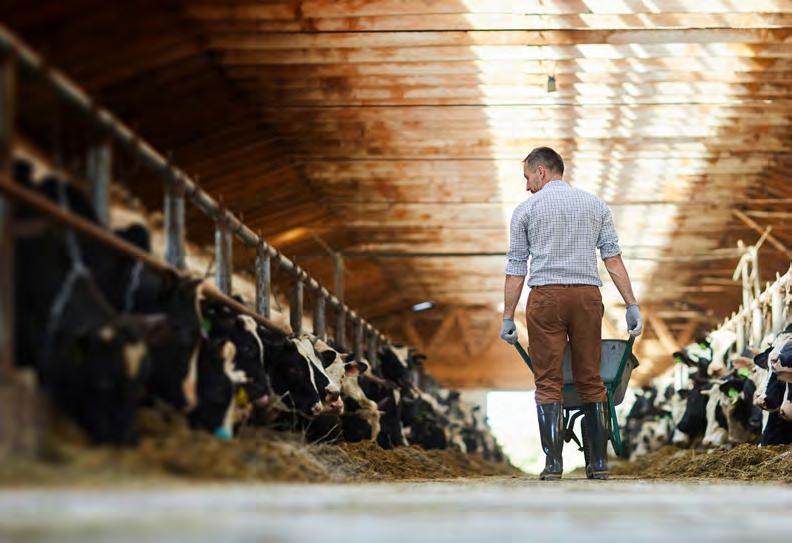
9 minute read
Calf housing
from Late Winter 2022
by MilkProducer
IS IT TIME TO CHANGE UP HOW CALVES ARE HOUSED?
Housing calves in pairs to increase social behaviours will become increasingly important in the future
By Oisin Graydon and Marlene Paibomesai CONTRIBUTOR
The majority of dairy farms in Canada raise calves individually. In the Canadian National Dairy Study, 63 per cent of respondents indicated calves are raised individually in pens or hutches (1). Events during the first few months of a calf's life, such as separation from the dam, a change in diet at weaning and, eventually, introduction to a larger group of calves, can be stressful.
Stress can impact disease susceptibility, growth and welfare by decreasing feed intake and negatively impacting a cow’s immune system. In addition, the expression of natural behaviours by domesticated animals, such as play and social interaction, is a growing area of public concern for all livestock farms. Isolation of herd animals at any time in the production cycle limits their ability to engage in social interactions. This could drive an expectation of raising calves in groups or in pairs to promote natural behaviours and maintain public trust. A collection of research over the last five years has found raising calves in pairs can decrease stress and improve growth and welfare, so is it time for change?
Calves housed individually allow the producer and-or calf manager to observe them more easily and ensure they are receiving all they need. Sickness is limited when calves are individually housed because they have less calf-to-calf transmission, and sick calves may be identified sooner when separated (2). However, disease arises from more than just housing style; there are many factors that contribute to disease, with stress being a large contributor to disease susceptibility (2). Housing calves in pairs can reduce stress, increase average daily gain (ADG) and feed efficiency and improve cognitive development.
BEHAVIOUR CHANGES OF PAIR-RAISED CALVES
In stressful situations, calves can often display behaviours, such as vocalizations, latency to eat, fearfulness of outsiders and decreased duration of play (3,4). Table 1 show data collected on a small herd of 40 calves to examine how isolation or companionship and diet during weaning would influence calf behaviours. The study found calves raised in pairs spent significantly more time feeding on solids, were much faster to approach a novel person and spent more time playing (2). Table 2 show data collected in another study that recorded the amount of vocalizations calves made during a three-day weaning period while they were housed in different conditions. The study found individually housed calves vocalized more throughout weaning than calves housed in pairs (3). saving labour and production costs.
Another study found calves placed into pairs at 14 days of age ate for longer periods, spent more time in the feed station, performed more social behaviours and spent more time playing. This means producers may be able to individually house calves for observational purposes for the first 14 days and still benefit from pair-raising. However, it is recommended calves be paired earlier than 14 days to benefit from improved growth in the pre-weaned phase (6). Pair-raised calves had higher ADG, starter intake before weaning and post weaning starter intake as shown in Table 3.
Raising calves in pairs can influence more than just how much they eat and grow; it can also influence their social development. It is believed play behaviour in calves can promote emotional and physical development, resulting in a more stress-resilient and easier to handle cow. When animals are isolated, they are unable to practice activities that require social contact or copying others' movements (social learning) (7). This can impact how they handle stressors later in life, such as responding to novel changes,
Table 1: Time spent playing and feeding and willingness to approach calf handlers of calves raised as pairs, individually or with the dam. Adapted from Duve, L.R et al. 2012.
Duration of play (seconds) Time feeding (seconds) Time to approach the handler (seconds)
Pair-raised - high 30.3 77 Pair-raised - low 32.2 810 84.88
Individual - high 36.2 314 146 Individual - low 2.41 629
Still on dam - high 24.9 322 194
Table 2: Vocalizations (calls per hour) of individually raised and pair-raised calves. Adapted from Bolt, S. L. et al., 2017.
Pre-weaning During weaning Postweaning
Individually raised 0.86+/-1.7 2.76+/-1.14 109.38+/51.40
Pair-raised at 5d old
Pair-raised at 28d old 0.10+/-0.9 0.73+/-0.21 26.08+/20.16
0.10+/-0.13 0.46+/-0.16 45.42+/26.77
FEEDING BEHAVIOUR AND AVERAGE DAILY GAIN INCREASES WITH PAIR-RAISED CALVES
When calves undergo changes in their diet, it can often decrease dry matter intake and result in reduced weight gain. This is also accompanied by increased stress often due to changes in group size and introduction to a new group of calves. Decreased ADG means it will take longer to reach target weights for weaning or breeding and require more feed to reach that milestone. When raised in pairs, calves start eating sooner, visit the feeder more often, spend more time at the feeder and have a higher feed intake after a diet change (4, 5). Improving these feeding behaviours is beneficial to producers because it can decrease the time to target weights,
Table 3: Average daily gain (ADG), pre- and post- weaning starter intake of calves raised as individuals, early or late paired raised. Adapted from Costa, J. et al., 2015
ADG (kg/d) Pre-weaning starter intake (kg/d)
. Post-
weaning starter intake (kg/d)
Pair-raised 0.31+/-0.07 0.18+/-0.03 2.20+/-0.22
Individual 0.17+/-0.07 0.07+/-0.03 1.09+/-0.25
Pair-raised after 15d 0.18+/-0.06 0.05+/-0.03 1.26+/-0.33
new objects in their environment or settling in with a herd.
Pair raising calves does require the farm to have top-notch newborn care and low calf mortality. According to University of Wisconsin Dairyland Initiative, to be successful at pair raising calves, a farm must have: •Less than three per cent pre-weaned calf mortality; •Failure or poor transfer of passive immunity less than five per cent in calves; •Less than 14 days age difference between calves, seven days preferred; •Resting area of at least 30 square feet per calf; •Adequate nutrition to reduce cross sucking (minimum eight to 10 litres per day by nipple) (2).
In order to maintain public trust, dairy calf housing will likely have to adapt to meet public expectation of animals being able to express their natural behaviours and reduce isolation periods. Pair raising calves is one possible change that can be made. Research over the past five years has aimed at understanding best management practices of pair raising calves. It is not as simple as putting two calves in the same pen, a farm must meet the above benchmarks, management and housing criteria to be successful at switching to pair raising calves.
This research has shown housing calves in pairs has production advantages: it can reduce stress, improve cognitive development and increase ADG and feed efficiency. More importantly, this housing style allows calves to socialize, reduce isolation and express their natural behaviours, such as play. Housing calves to include positive social interactions will become increasingly important in the future. References: 1) Winder, C.B. et al. (2018) Canadian National Dairy Study: Heifer calf management. J. Dairy Sci. 101:10565-10579. 2) Van Os, J. (2021, January 21). Benchmark for calf health before pair housing. University of Wisconsin-Madison. https://animalwelfare. cals.wisc.edu/wp-content/uploads/ sites/243/2021/01/02-Benchmarks-for-calfhealth-before-pair-housing.pdf 3) Duve, L.R., et al. (2012). The effects of social contact and milk allowance on responses to handling, play, and social behavior in young dairy calves. J. Dairy Sci., 95(11), 6571-6581. 4) Bolt, S. L., et al., (2017). Pair housing of dairy calves and age at pairing: Effects on weaning stress, health, production and social networks. PLOS ONE, 12(1), e0166926. 5) De Paula Vieira, A., et al. (2010). Effects of pair versus single housing on performance and behavior of dairy calves before and after weaning from milk. J. Dairy Sci, 93(7), 3079-3085. 6) Costa, J., Meagher, R.k., Von keyserlingk, M., & Weary, D.m. (2015). Early pair housing increases solid feed intake and weight gains in dairy calves. J. Dairy Sci, 98(9), 6381-6386. 7) Costa, J., Von keyserlingk, M., & Weary, D.m. (2016). Invited review: Effects ofgroup housing of dairy calves on behavior, cognition, performance, and health. J. Dairy Sci, 99(4), 2453-2467.

Dr. Marlene Paibomesai
is a dairy specialist for the Ontario Ministry of Agriculture, Food and Rural Affairs (OMAFRA).
Oisin Graydon
was a summer student at OMAFRA in the summer of 2021 and is currently an undergraduate student at the University of Guelph.

Contact us for dealer names and locations. HARRISTONSALES
Wes| wesh@harcoag.ca Jake|jakeh@harcoag.ca
TERRITORY TERRITORY MANAGERMANAGER
ShannonLittle shannonl@harcoag.ca 519-323-7614
5808Hwy#9 | Harriston,ONNOG1 ZO | sales@harcoag.ca 1-800-461-0847 | www.harcoag.ca
EVALUATING COOL-SEASON CHICKPEA AS AN ALTERNATIVE POTENTIAL FEED SOURCE FOR DAIRY COWS
By Dr. Peiqiang Yu CONTRIBUTOR
Low-grade chickpeas or non-food chickpeas can potentially be used as alternative protein and energy supplement for dairy cows. Researchers at the Crop Development Center (CDC) at the University of Saskatchewan examined the effect of the nutritional characteristics of three cool-season chickpeas developed by CDC as an alternative protein and energy supplement for dairy cows.
The studies were carried out by graduate student Linda Cerma at the department of animal and poultry science, college of agriculture and bioresources in collaboration with several professors and researchers. The chickpeas samples, which included CDC frontier, CDC cory and CDC alma, were harvested from three locations in Western Canada.
CDC alma is a kabuli variety with white flowers. Its seed shape has a medium ram head and can take up to 104 days to reach maturity. It has a fair reaction from ascochyta. CDC cory is a desi variety, with good resistance for ascochyta. It can grow up to 49 centimetres and has a high yield. CDC frontier is also a kabuli variety and produced in brown and dark brown soil zones of Western Canada. It has a pinnate leaf type, white flowers, yellow cotyledons and cream seed coat colour.
COWS HATE STALLS
New Research confirms once again that cows hate using stalls, so why do we keep using them? There’s a great new way to house your cows. No more scraping, or bedding, or replacing stalls and no it’s not a pack barn, it’s a PASTURE BARN DESIGNS BRINGING THE PASTURE IN
• LOWEST CAPITAL COST • LOWEST VARIABLE COST • LOWEST ENVIRONMENTAL IMPACT
Donald Russell 613-639-0370 www.pasturebarndesigns.com pasturebarndesigns@outlook.com
It’s more than your livelihood, it’s your life.
RESEARCH FINDINGS
The study showed there were no significant differences in total truly digested protein supply among varieties although CDC frontier had numerically higher truly digested protein supply (+27 grams per kilogram of dry matter) than CDC cory and CDC alma.
Using National Research Council’s dairy model analysis, the researchers found CDC frontier provided a higher total metabolizable protein for dairy cows and was lower in degraded protein balance than the other two varieties.
For feed milk value (FMV) based on total truly digested protein supply, the researchers found CDC frontier had higher milk per kilogram of feed than the other two varieties.
TAKE-HOME MESSAGE
In general, cool-season chickpeas had low rumen undegraded protein and high rumen effective degradation protein content. The variety did impact nutritional value in terms of degraded protein balance, truly digestive protein supply to dairy cows and FMV.
Dairy farmers will want to consider a precision feeding strategy when incorporating cool-season chickpeas in their dairy cows’ diets.

You deserve an advisor who really gets what’s on the line. Find an advisor near you.
MNP.ca/onag
Dr. Peiqiang Yu
is a professor and Ministry of Agriculture Strategic Feed research chair in feeds R&D, department of animal and poultry science, college of agriculture and bioresources at the University of Saskatchewan. Researchers Dave Christensen, Rex Newkirk and Bunyamin Tar’an provided the chickpea samples for the study. The SRP feed chair research programs have been supported by various funding agencies and industry organizations.








